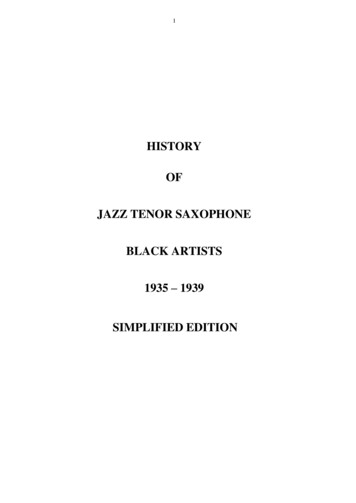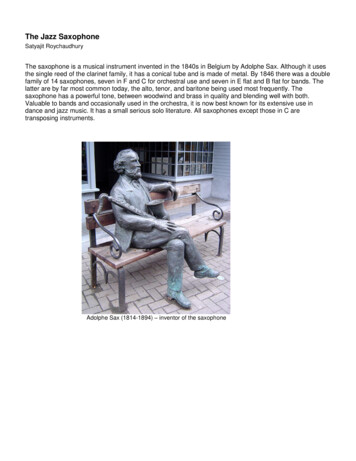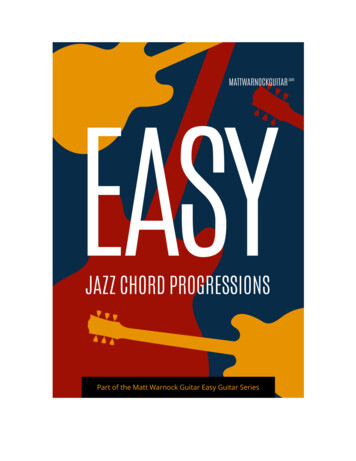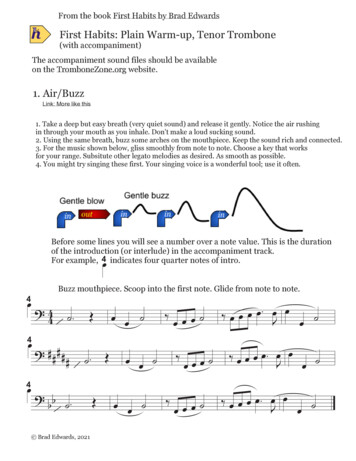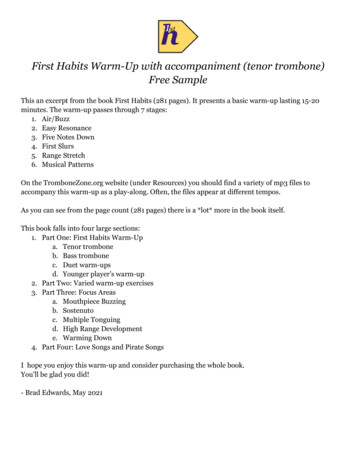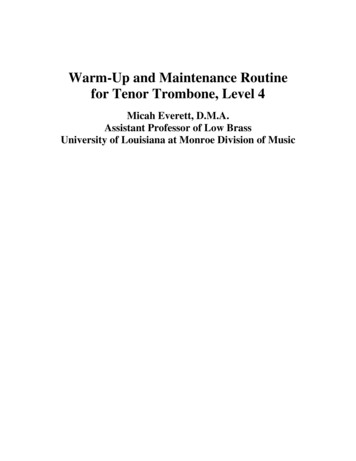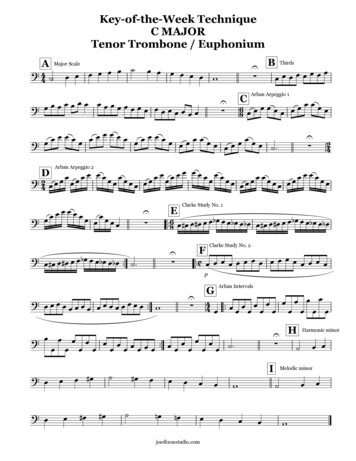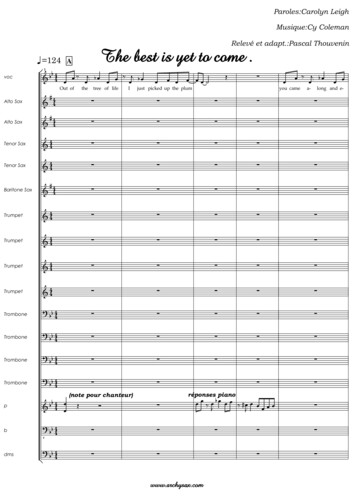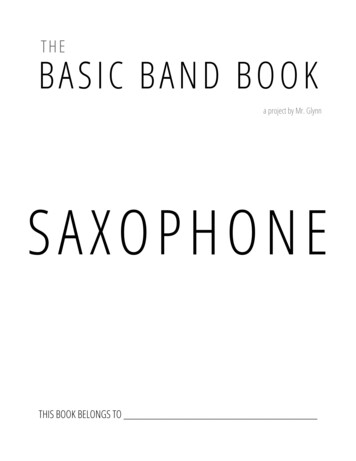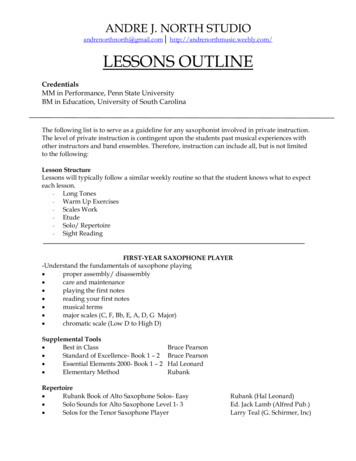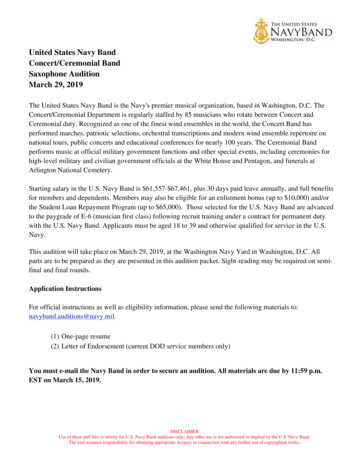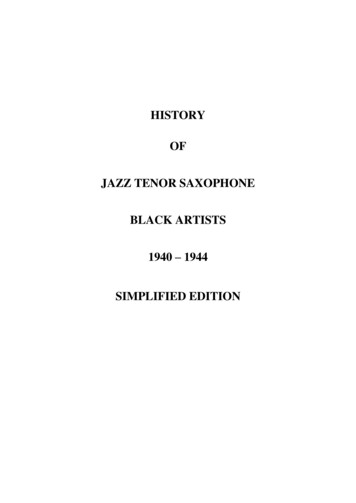
Transcription
HISTORYOFJAZZ TENOR SAXOPHONEBLACK ARTISTS1940 – 1944SIMPLIFIED EDITION
INTRODUCTION UPDATESIMPLIFIED EDITIONI have decided not to put on internet the ‘red’ Volume 3 in my Jazz Solographyseries on “The History of Jazz Tenor Saxophone – Black Artists 1940 – 1944”.Quite a lot of the main performers already have their own Jazz Archeology files.This volume will only have the remainders, and also auxiliary material like statusreports, chronology, summing ups, statistics, etc. are removed, to appear later inanother context. This will give better focus on the many good artists whonevertheless not belong to the most important ones.Jan EvensmoJune 22, 2015INTRODUCTIONORIGINAL EDITIONWhat is there to say?That the period 1940 - 1944 is a most exciting one, presenting the tenorsax giants ofthe swing era in their prime, while at the same time introducing the young, talentedmodern innovators.That this is the last volume with no doubt about the contents, we know what is jazzand what is not. Later it will not be that easy!That the recording activities grow decade by decade, thus this volume issubstantially thicker than the previous ones. Just wait until Vol. 4 appears .That the existence of the numerous AFRS programs partly compensates for theunfortunate recording ban of 1943.That there must be a lot of material around not yet generally available and thus notlisted in this book. Please help building up our jazz knowledge base, and share yourtreasures with the rest of us.That we should remember and be eternally grateful to the late Jerry Newman, whoserecording activities at Minton's and Monroe's have given us valuable insight into thedevelopments of modern jazz.That jazz is a major art form, to be documented as well as possible for the benefit ofthe 3rd millenium.That jazz also is great fun!Jan EvensmoNovember 20, 1997
2"GENE" EUGENE STANLEY AMMONS"JUG"Born: Chicago, Illinois, April 14, 1925Died: Chicago, Illinois, Aug. 6 or 7, 1974Transferred to separate Jazz Archeology file.ERNEST ALVIN ARCHIA“TOM”Born: Groveton, Texas, Nov. 26, 1919Died: Houston, Texas, Jan. 16, 1977Transferred to separate Jazz Archeology file.ULYSSES BANKS"BUDDY"Born:Died:Continued from 1939.With Cee Pee Johnson through the early forties.CEE PEE JOHNSON AND HIS ORCHESTRAHollywood, ca. Dec. 1943Teddy Buckner, possibly Karl George (tp), unknown (tb), possibly Edward Hale(as), possibly Chuck Walker (as, bar), Buddy Banks, W. Woodman Jr. (ts), JoeLiggins (p), possibly Ted Shirley (b), possibly Rabon Tarrant (dm), Cee PeeJohnson (ldr, vo, tom-tom, dm), Ivie Anderson (vo-AND-10), Ida James(vo-JAM-19,20), Johnny Mercer (vo-MER-1,2).AFRS Jubilee No. 57, 60 and 61.JOH-1Boogie Woogie LouSolo 16 bars. (FM)JOH-2Jumpin' In The GrooveJOH-3Leave Us, LindaJOH-4Mop, MopJOH-5One O'Clock Jump (NC)Solo 24 bars. (FM)JOH-6Sherman ShuffleSolo 16 bars. (FM)JOH-7Slew FootJOH-8Southern FriedJOH-9Swing CrazyJOH-10Unidentified TuneAND-10Play Me The BluesFaint obbligato. (S)JAM-19Baby, Knock Me A KissFaint obbligato. (S)JAM-20On The Sunny Side Of The StreetFaint obbligato. (S)MER-1The G.I. JiveNo solo.MER-2Knock Me A KissNo solo.Soli 8, 8 and 16 bars. (FM)Solo 16 8 bars, (tp) on bridge. (FM)Soli 4 and 4 bars. (FM)No solo.Solo 8 bars. (FM)Solo 16 bars. (FM)Soli 16, 16 and 8 bars. (FM)Note: I have chosen to list all tenorsax soli on these programs here, but they areshared between BB and WW jr. There is no material available which might help inidentifying their respective contributions. "Jumpin' ." and ". Tune" feature bothtenorsax players.The Cee Pee Johnson shows contain some of the most interesting "unknown" blackbig band music of the early forties. A colourful, professional band with goodsoloists, having the misfortune to be on the "wrong coast". There is a lot of good
3tenorsax playing on these shows, mostly by one performer. Play "Sherman Shuffle","Southern Fried" or "Baby .", and you wil feel the same way I do: BB and WWcould have been great names in jazz tenorsax under the right circumstances; strong,virile tone, technique and inventiveness, just go! But they never seemed to make it.Why?To be continued in 1945."TED" BARNETTBorn:Died:TB records on (as) with Jimmy Mundy in 1939 and Lucky Millinder 1941-42.Played with Benny Carter 1942. It is suggested that he is present on:CLAUDE HOPKINS AND HIS ORCHESTRANYC. ca. Oct. 1944Possible personnel: Shirley Clay, Kenneth A. Roane (tp), Jimmy Archey, SandyWilliams (tb), Joe Evans, Pinky Williams (as), Joe Garland, Ted Barnett (ts), JohnRicks (bar), Claude Hopkins (p), John Benjamin Peabody Brown (b), Wilbert Kirk(dm).AFRS Jubilee No. 100, 101 and 102.There are two tenorsax soloists on these programs, the complete list of soli to befound under Joe Garland.To be continued in 1947.PAUL BASCOMBBorn: Birmingham, Alabama, Feb. 12, 1910Died: Chicago, Illinois, Dec. 2, 1986Continued from 1938.ERSKINE HAWKINS AND HIS ORCHESTRANYC. June 10, 1940Erskine Hawkins (tp, arr, ldr), Sam Lowe, James Harris, Marcellus Green (tp),Edward Sims, Robert Range (tb), William Johnson (as), Jimmie Mitchelle (as, vo),Paul Bascomb, Julian Dash (ts), Haywood Henry (cl, bar), Avery Parrish (p),William McLemore (g), Leemie Stanfield (b), James Morrison (dm).Five titles were recorded for Bluebird, two have tenorsax, both PB:051261-1Sweet Georgia BrownBreak 4 bars to solo 5 chorusesof 32 bars, partly with orch,to coda 16 bars. (F)051263-1Five O'Clock WhistleSolo 8 bars. (M)NYC. Nov. 6, 1940Same, except Wilbur Bascomb (tp) replaces Harris.Four titles were recorded, three have tenorsax, two PB:057363-1Norfolk Ferry057365-1NonaSoli 8 and 8 bars (last tenorsax soli). (FM)Solo 48 bars. (M)NYC. Nov. 20, 1940Personnel as Nov. 6.Four titles were recorded, one has tenorsax by PB:057725-1I Know A SecretChase 24 bars with JD. (M)PB has matured since his previous recordings with Erskine Hawkins, this is foremostevident in the beautiful "Nona", a performance which ranks him with the greatesttenorsax stars of the era. In a style crossbred by Dick Wilson, Chu Berry and BenWebster, he plays a memorable solo. He also receives the rare honor of a featurenumber, all for himself: "Sweet Georgia .". He does a very able job; the occasion initself is unusual, and if the results are not quite up to PB's abilities, it is due to arather stiff rhythm section; compare with Chu's "46 W 52nd" and Sid Catlett. But byany standards, this is good tenorsax playing! In ". Secret" he chases JD; thestructure is: PB 2, JD 2, PB 2, JD 2, PB 4, JD 4, PB 8 bars!
4PB was a temporary replacement for Lester Young and recorded with COUNTBASIE AND HIS ORCHESTRA in NYC. Dec. 13, 1940, four titles but no soli.ERSKINE HAWKINS AND HIS ORCHESTRANYC. Jan. 22, 1941Personnel as Nov. 6, 1940 plus Richard Harris (tb) and Ida James (vo).Three titles recorded for Bluebird, two issued, one tenorsax item, no PB.NYC. May 15, 1941Same. Six titles were recorded, three have tenorsax, one is by PB:065729-1Blue SeaSolo 24 bars. (M)NYC. May 27, 1941Same. Four titles were recorded, three issued, one has tenorsax by PB:065910-1I'm In A Low Down GrooveSolo 28 bars. (SM)NYC. Aug. 8, 1941Same. Three titles were recorded, all have tenorsax, probably one by PB:067547-1Jumpin' In A Julep JointSolo 16 bars. (M)NYC. Dec. 22, 1941Same. Four titles were recorded, three issued, one has tenorsax, but no PB.NYC. May 27, 1942Same, except Edward McConney (dm) replaces Morrison.Four titles were recorded, three have tenorsax, probably all by JD.NYC. June 29, 1942Same as May 27. Three titles were recorded, but no tenorsax.If there was any doubt, "Blue Sea" and ". Low Down Groove" prove that PB wasone of the tenorsax players closest to the established stars. I wonder why JD isfeatured more often on the Erskine Hawkins recordings, because PB definitely is thesuperior player. The delicate conception of "Blue Sea" bears the stamp of a greatartist, and the slow medium ". Groove" similarly has the special ingredients of jazzperformances to last forever, note particularly the last half which ends up in tenorsaxheaven!ERSKINE HAWKINSAND HIS ORCHESTRAHollywood, ca. Aug. 9, 1943Personnel suggested by Lotz/Neuert to be: Erskine Hawkins (tp, vo, ldr), CharlieJones, Dud Bascomb, Ed Sims (tp), Don Cole, David James, Norman Greene (tb),Bobby Smith (as), Jimmie Mitchelle (as, vo), Julian Dash, Paul Bascomb (ts),Haywood Henry (cl, bar), Gene Rodgers (p), Bill Johnson (g), Leemie Stanfield (b),Kelly Martin (dm).AFRS Jubilee No. 43 (items HAW-4, 7, 9, 10, 12, 14), 45 (items HAW-3, 5, 11, 12)and 48 (items HAW-6, 8, 12, 13, 15), possibly also 44 and 47.HAW-3Bicycle BounceSolo 32 bars. (M)HAW-4Don't Cry BabyNo solo.HAW-5Get Up MuleNo solo.HAW-6I Got RhythmNo solo.HAW-7Jubilee HopHAW-8Let's Ball AwhileHAW-9Let's Go HomeHAW-10Limehouse BluesHAW-11No SoapHAW-12(43)One O'Clock Jump (NC)Solo 24 bars to solo 24 barsto solo 20 bars (NC). (FM)HAW-12(45)One O'Clock Jump (NC)Solo 36 barsto solo 28 bars (NC). (FM)HAW-12(48)One O'Clock Jump (NC)Solo 36 barsto solo 12 bars (NC). (FM)Soli 24 and 24 bars. (F)Solo 18 bars. (FM)Solo 64 and 32 bars. (FM)No solo.Solo with orch 5 chorusesof 32 bars to coda. (F)
5HAW-13Somebody's Rockin' My Dream BoatNo solo.HAW-14Tuxedo JunctionNo solo.HAW-15Tuxedo JunctionSoli 16, 16 and 16 bars. (M)JOH-11Straighten Up And Fly RightNo solo.THA-6Sin Is To BlameNo solo.sameSame. AFRS Downbeat No. 111. The full details are given under JD, however, thefollowing two titles seem to be "alternate takes" of HAW-9 and HAW-15respectively:Let's Go HomeSoli 64 and 32 bars. (FM)Tuxedo JunctionSoli 16, 16 and 16 bars. (M)There is some exquisite tenorsax playing on these programs! There are certainly twoperformers, and the suggestion PB/JD seems quite likely. The most memorablepiece is "Let's Go Home!", where the longest solo is magnificent in the Chu Berrytradition, in fact, more close in style than I have ever heard, with the exceptionmaybe of the early John Hardee recordings! Probably the last solo here is by JD.There are different versions on Jub 43 and DB 111, obviously recorded at the samedate. "Tuxedo ." also has two takes featuring both performers, lots of differences.Both tenorsax players also have very fine contributions on ". Hop", here I believePB takes the last solo. ". Awhile" is bleaker, probably JD. "One O'Clock ." is abig surprise, each of the three Jubilee programs uses a different version, all includingtwo tenorsax players, and all excellent!! This is what jazz research is all about!Summing up: These are really interesting programs for tenorsax lovers!!SAMMY PRICENYC. March 1944Tommy Allinson, David Nelson (tp), Joe Eldridge (as), Paul Bascomb (ts), SamPrice (p), Jimmy Butts (b), Harold Wilson (dm), Bettye Logan (vo).Four titles were recorded for Decca, unissued.Leading a sextet and then a bigband with his brother Dud 1944 - 1947.To be continued in 1945.SIDNEY BECHETBorn: New Orleans, Louisiana, May 14, 1897Died: Paris, France, May 14, 1959This prominent artist, eternally famous for his clarinet and sopranosax, is heard ontenorsax on one occasion, namely the extraordinary trick-recording:SIDNEY BECHET's ONE-MAN BANDSidney Bechet (cl, sop, ts, p, b-63785, dm-63785).Two titles were recorded for Victor:NYC. April 18, 1941063785-1The Sheik Of ArabyProminent tenorsax on whole record. (FM)063785-2The Sheik Of ArabyAs above. (FM)063786-1Blues Of BechetProminent tenorsax on whole record. (S)It is difficult to make any judgement from this bizarre event. SB plays tenorsax in astyle very similar to his soprano sax. His tenorsax vibrato would have beenrecognizable anywhere. He probably would have been an important artist on anyinstrument. Note particularly the first chorus after the piano on "Blues ."LEON BERRY"CHU"Born: Wheeling, West Virginia, Sept. 13, 1910Died: Conneaut, Ohio, Oct. 31, 1941Transferred to separate Jazz Archeology file.
6HENRY BRIDGES"HANK"Born: Oklahoma City, ca. 1908Died: 1986Transferred to separate Jazz Archeology file.IRVING B. BROWN"SKINNY"Born:Died:AL COOPER AND HIS SAVOY SULTANSNYC. March 29, 1940Al Cooper (cl, as, bar, arr-67433, dir), Pat Jenkins, Sam Massenberg (tp), RudyWilliams (as), Skinny Brown (ts), Cyril Haynes (p, arr-67436), Paul Chapman (g,vo-67434), Grachan Moncur (b), Alex Mitchell dm), Evelyn White (vo-67435).Four titles were recorded for Decca, three have tenorsax:67433-AFrenzySoli 8 and 8 bars. (F)67434Stop And Ask Somebody67436Sophisticated JumpSolo 24 bars. (M)Soli 4, 4 and 4 bars. (M)Quite competent tenorsax playing, swinging pleasantly in medium tempo, but thefast "Frenzy" is the most attractive item.IBB is present on a recording session on (cl, as) with CAB CALLOWAY on July27, 1942.To be continued in 1950."VI" VIOLET BURNSIDEBorn:Died:VB was featured as a soloist with the Harlem Playgirls in the mid-thirties and thenwith the International Sweethearts of Rhythm from Summer/Fall 1943 until themid-forties:INTERNATIONAL SWEETHEARTS OF RHYTHMprob. late 1943Bigband personnel including Anna Mae Winburn (vo, ldr), Ernestine "Tiny" Davis(tp), Helen Jones (tb), Rosalind "Roz" Cron (as), Helen Saine (as, bar), VioletBurnside (ts), Pauline Bradley (dm).Movie "She's Crazy With The Heat" and possibly others. I have only seen excerpts,therefore details are not clear. At least four items have tenorsax:Do You Wanna Jump Children?Unidentified BluesUnknown TitleShe's Crazy With The HeatSolo 12 bars. (M)Solo 24 bars. (F)Solo with orch 64 bars. (FM)Solo 20 bars. (F)The first female player in "The history of jazz tenorsaxophone" and with fewsuccessors, none as important as VB. To state that she "plays like a man" is perhapsan antique mode of expression, but it is meant to be a compliment! There are norecords by this unique, mixed orchestra until the late forties. This film or collectionof movie shots from the same session is probably from the early forties. VB playswith strength, inventiveness and authority, and we can only regret deeply that hermusic is so sparsely preserved for the future. Note: ". Heat", is it
series on “The History of Jazz Tenor Saxophone – Black Artists 1940 – 1944”. Quite a lot of the main performers already have their own Jazz Archeology files. This volume will only have the remainders, and also auxiliary material like status reports, chronology, summing ups, statistics, etc. are removed, to appear later in another context. This will give better focus on the many good .
